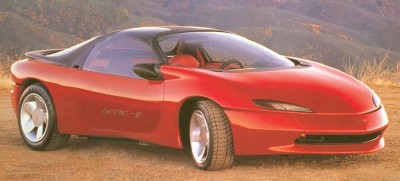1989 Chevrolet California Camaro Iroc-Z
- Story Cars

- Dec 8, 2020
- 2 min read
The design of the 1989 Chevrolet California IROC Camaro concept car offered several surprises to Camaro fans who had thought they knew the car inside and out.
The concept Camaro was given quasi-gull-wing doors that pulled upward and hauled part of the glass roofline along with them. They also shifted forward at a 45-degree angle, so you didn’t have to be a contortionist to slip into the driver or passenger seat. Seating was 2+2, just like the contemporary Camaro, and more than likely was just as cramped in the back, though the three-inch stretch in wheelbase helped some.
Formula One racers inspired the layout of the Chevrolet California IROC Camaro. Once inside, the driver faced a full set of analog instruments (and a digital speedometer) in a cockpit that felt more like that of an airplane than an automobile. Just in case you forgot where to sit, the swiveling driver’s seat was red upholstery while the passengers rested on black.
The red seat could even be custom-fitted to a single driver -- which might have caused a bit of discomfort and irritation when the spouse or youngsters took the car out for an evening. Maybe not, though, because the interior was designed to offer a precise relationship between arms, legs, steering wheel, and pedals -- handling a broad variety of (human) body types and sizes. So maybe everybody would be relatively comfy.
That same precise relationship extended to the nearby, high-mounted gearshift lever, which traveled with a mercifully short throw from one ratio to the next. There is no need to reach halfway across the front passenger to snick into top gear. Performance fans loved it.
Nobody liked to settle their designer jeans onto dusty upholstery, so Chevrolet thoughtfully included a little vacuum cleaner in the console, with the urging that the driver better wait until standstill, for safety’s sake, before switching on the suction.
With both Camaro and IROC monikers attached to the car, it was a sure bet that performance wouldn’t be ignored, though the folks at GM weren’t ready for some time to name a specific powertrain for any production version. However, the prototype carried a dual over-head cam V-6, leading observers to believe that if a readable version of the California Camaro appeared, horsepower might run in the neighborhood of 250.
All Camaros in the past had come with a choice of engines, so at least one smaller powerplant was sure to be offered. Not every customer demanded the sensation of being rudely shoved back when tromping hard on the gas pedal. Thankfully, hefty 17-inch tires (P235/50R17 at the prototype’s rear) handled the top end of the engine spectrum without flinching.
Source: auto.howstuffworks.com
Images: Concept Car Central; Publications International, Ltd.

%20(4)_edited.png)














































Comments